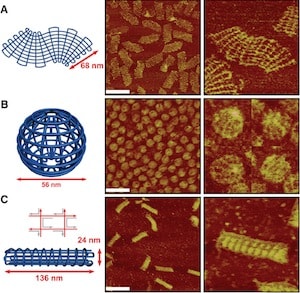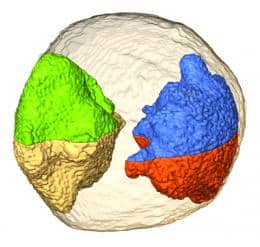Nanotechnology researchers in London have used a scanning tunneling microscope to create atomically precise quantum states from dangling bonds on a silicon surface.
Atomically precise placement of dangling bonds on silicon surface


Nanotechnology researchers in London have used a scanning tunneling microscope to create atomically precise quantum states from dangling bonds on a silicon surface.

Revolution of DNA around a central channel, rather than rotation, is the method used by a viral molecular motor to package DNA. A structure facilitating bottom-up assembly may lead to roles in nanotechnology for these nanomotors.
In anticipation of Eric Drexler’s new book, Forbes contributor Bruce Dorminey interviews him about the meaning of nanotechnology and its revolutionary prospects. Selected excerpt: … In what fields would APM cause the most pronounced economic disruption and the collapse of global supply chains to more local chains? The digital revolution had far-reaching effects on information… Continue reading Nanotechnology revolution: An interview with Eric Drexler

By forcing the geometry of the junctions upon which DNA nanotechnology depends, researchers have increased the collection of 2D and 3D structures that they can build to include wire frames and mesh structures.

Researchers from UCLA’s California NanoSystems Institute and Northwestern University have combined multiple imaging techniques to produce high quality 3D images of platinum nanoparticles, allowing advanced visualization of atomic-scale structural defects (an important advancement over X-ray crystallography). The original 2012 work, published in Nature and posted by Jim Lewis here, used electron tomography to study 10-nm… Continue reading New advancement in 3D imaging of nanoparticles at atomic resolution

Nanoparticles decorated to avoid immune system recognition were tested in mice and shown to survive longer and deliver more imaging dye and drug to tumor cells.
In this Forbes interview, contributor John Nosta introduces us to a teen worth watching: fifteen-year-old Jack Andraka, whose effort to design a nanotube-based sensor for pancreatic cancer detection was initially ignored. The interview taps into some aspects of how innovation occurs and the challenges of bringing new ideas to fruition – aspects which transcend age,… Continue reading A teenager's step toward nanomedicine innovation

A proposed large project to produce a dynamic map of the functional connectome of the human brain will require a convergence of neuroscience, biotechnology, nanotechnology, and computation, and may therefore spur the development of advanced nanotechnology leading to molecular manufacturing.

The advent of new technologies is typically followed by new government regulation, and in the absence of data, fear-based reactionism can have far too much influence on policy. Quality research studies on real risks and impacts of nanoscale technologies can help lead to legitimate scientific consensus and appropriate regulation. Engineered nanoparticles draw particular attention, because… Continue reading Studying environmental impacts of nanoparticles using mesocosms

Core-shell nanocapsules deliver a potent protein complex to the nucleus of cancer cells where it induces them to commit suicide, while the complex degrades harmlessly in the cytoplasm of normal cells.